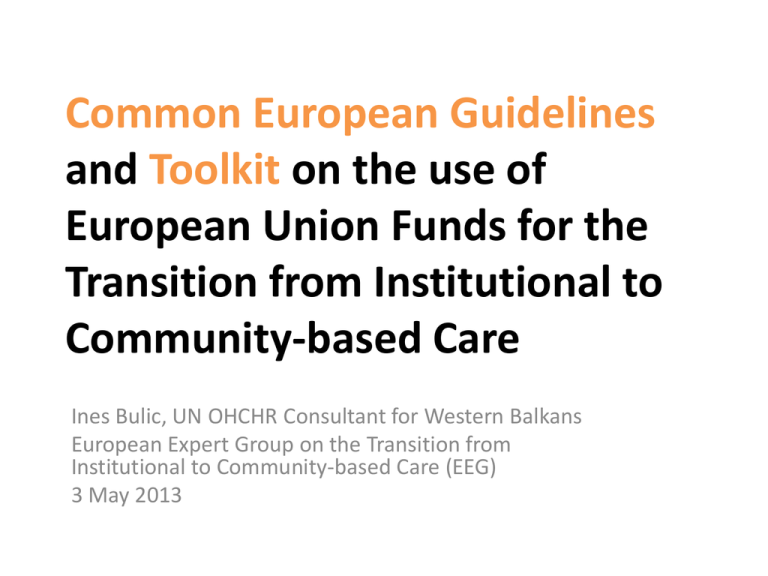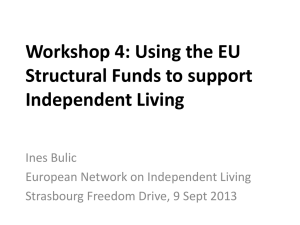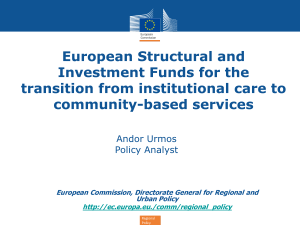Common European Guidelines Toolkit and on the use of
advertisement

Common European Guidelines and Toolkit on the use of European Union Funds for the Transition from Institutional to Community-based Care Ines Bulic, UN OHCHR Consultant for Western Balkans European Expert Group on the Transition from Institutional to Community-based Care (EEG) 3 May 2013 Overview of the presentation • About the European Expert Group • Common European Guidelines on the Transition from Institutional to Communitybased Care • Toolkit on the use of European Union funds About EEG Broad coalition gathering stakeholders representing people with care or support needs including children, people with disabilities, people experiencing mental health problems, families; as well as service providers, public authorities and intergovernmental organisations. Achievements so far • Report of the Ad Hoc Expert Group (so-called Commissioner Špidla’s Report) (2009) • Advising European Commission (DG EMPL and DG REGIO) on the use of EU SF in Bulgaria, Czech Republic, Hungary, Slovakia, Serbia • Advising the Member States, for example Bulgaria, Czech Republic, Slovakia Why the Guidelines? “Though governments increasingly recognise the inevitability of deinstitutionalisation, there is less clarity with regard to the mechanisms that replace institutionalisation and what would constitute a human rights-based response.” COE Human Rights Commissioner, 2012 Objectives of the Guidelines • Offer expertise and impartial advice to Member States and EU institutions • Gather and promote practical examples of good practice • Raise awareness about the right to live in the community at EU level • Ensure that EU and national policies and funding mechanisms support DI • Encourage Member States to fully involve user groups Key elements • “Common” means children, people with disabilities, incl. • • • • • people with mental health problems, and older people Tailored to Member States at different stages in the process of transition Guidance on how to ensure actions taken are in line with the CRPD, CRC and the ECHR Key guidance outlining risks and challenges in the process Case studies presenting good practice Emphasis on management, cross-sectoral coordination and user involvement Holistic approach to DI • Development of high-quality, individualised services in the community, including those aimed at preventing institutionalisation and the transfer of resources from institutions to the new services • Planned closure of long-stay residential institutions, including a moratorium on the building of new institutions • Making mainstream services accessible and available to individuals with a variety of support needs Making the case for developing community-based alternatives to institutions Assessment of the situation Developing a strategy and an action plan Establishing the legal framework for community-based services Developing a range of services in the community Allocating financial, material and human resources Developing individual plans Supporting individuals and communities during transition Defining, monitoring and evaluating the quality of services Developing the workforce Why the Toolkit? Key elements of the Toolkit Main principles and the legal context Programming stage Implementation Monitoring and evaluation • What we mean by DI • Human rights argument for DI • Potential of EU funds • Current regulations 20072013 • Draft regulations 2014-2020 • Checklist for Partnership contracts • Indicative list of actions for ESF and ERDF • Output and result indicators for ESF and ERDF • Operational Programmes checklists • Checklist for the selection of projects • Checklist for monitoring • Lessons learned 2007-2013 • Checklist for evaluations Potential for change in the next programming period • Supporting structural change in the health and social care systems • Combining investments into infrastructure with workforce development and improving mainstream services • Supporting sustainable reforms • Promoting social innovation • Simplified rules Common Provisions Regulation • Objective on promoting social inclusion and combating poverty • Need to comply with EU and national law (i.e. UN Convention on the Rights of Persons with Disabilities) • Prevention of discrimination Ex ante conditionalities • Thematic – strategy for a shift from residential to community-based care • General – mechanism to ensure effective implementation of UN CRPD Fund specific regulations • “Promoting social inclusion and combating poverty” an investment priority • Explicit reference to transition from institutional to community-based care • Principles of equal opportunities and nondiscrimination Common Strategic Framework • Transition from institutional to community-based care as one of key ESF and ERDF actions • General implementation principle: the CSF funds may not be used for actions contributing to any form of segregation and discrimination • Other key actions such as education and enhancing institutional capacity www.deinstitutionalisationguide.eu Available Coming soon English German French Czech Bulgarian Romanian Croatian Lithuanian Greek Hungarian Polish Russian Ukrainian Slovak Contact information Ines Bulic coordinator@community-living.info Thank you!






